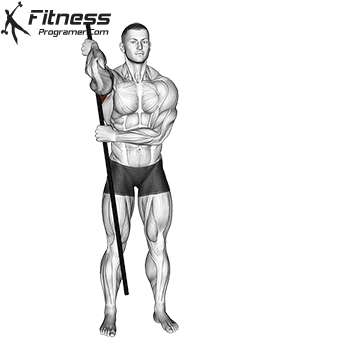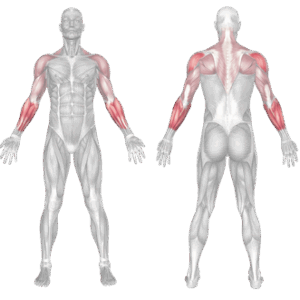Overview
The Front Rack PVC Stretch is a mobility drill that uses a light PVC pipe to mimic the front rack position with an emphasis on alignment and joint range of motion. By holding the PVC with elbows lifted and upper arms parallel to the ground, it opens the thoracic spine and stretches the wrists and shoulders. It’s commonly used in Olympic lifting warm-ups and corrective mobility sessions.
How to do perform Front Rack PVC Stretch

Grip a PVC pipe at shoulder-width, with palms facing up (supinated grip).
Lift the pipe up to chest level, mimicking the front rack position.
Raise your elbows until they are parallel with the ground.
Pull the bar lightly into your neck or collarbone, keeping wrists extended and shoulders externally rotated.
Hold the position for 20–30 seconds, keeping the upper back upright and the ribcage down.
Repeat for 2–3 sets, breathing deeply to enhance relaxation and range of motion.
Tips for Proper Form
Keep elbows lifted and parallel with the floor throughout the stretch.
Avoid shrugging the shoulders up toward the ears.
Use a relaxed grip to avoid excessive tension in the forearms.
Engage your core to prevent excessive arching in the lower back.
Focus on deep, steady breathing to improve stretch depth and control.
Common Mistakes
Elbows dropping too low, reducing the stretch in the upper arms and shoulders.
Overextending the lower back, which compensates for poor thoracic mobility.
Gripping the PVC too tightly, causing unnecessary wrist tension.
Shrugging the shoulders, reducing isolation of the front rack mobility targets.
Leaning forward, taking tension off the targeted joints.
Benefits of the Front Rack PVC Stretch
Improves Front Rack Position: Helps achieve a more upright torso and better bar support during cleans and front squats.
Increases Wrist Flexibility: Stretches the wrist extensors, reducing discomfort during barbell lifts.
Enhances Shoulder External Rotation: Improves joint alignment for overhead and rack positions.
Promotes Thoracic Extension: Opens up the upper back for better posture and breathing mechanics.
Reduces Risk of Injury: Addresses common tightness in the rack position, reducing strain on wrists and elbows.
Improves Lifting Efficiency: Enables stronger, more technically sound front squats and Olympic lifts.
Works Well in Warm-Ups: Simple and portable for pre-lift routines, movement prep, or cool-downs.
How to Incorporate Into Your Routine
- For Beginners: Hold the stretch for 20 seconds, 2–3 rounds, before cleans or front squats.
- For Olympic Lifters: Use as part of a warm-up to prepare for cleans, jerks, and overhead work.
- For Strength Athletes: Add between sets to maintain mobility during front rack sessions.
- For Functional Training: Use in prep circuits or mobility flows involving loaded carries or rack holds.
- For General Fitness: Include in flexibility routines to combat postural tightness from sitting or desk work.
- For Recovery Days: Use as a gentle mobility tool to maintain shoulder and wrist health.
Muscles Worked

Frequently Asked Questions
Is the front rack PVC stretch good for wrist pain?
Yes. It helps stretch tight wrist extensors, but modify or reduce intensity if discomfort increases.
Can I do this daily?
Absolutely. Light daily mobility work improves long-term joint health and range of motion.
What can I use instead of a PVC pipe?
A broomstick, wooden dowel, or light bar will also work.
Why are my elbows dropping during the stretch?
You may have limited shoulder or triceps mobility. Practice consistently and gradually increase range.
Does it help my clean technique?
Yes. A more mobile and upright front rack position improves bar placement, stability, and transition to the squat.
